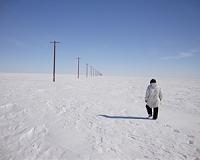| . |  |
. |
Licapa, Peru (AFP) June 28, 2010 In a remote corner of the Peruvian Andes, men in paint-daubed boilersuits diligently coat a mountain summit with whitewash in an experimental bid to recuperate the country's melting glaciers. It's a bizarre sight at 4,756 metres (15,600 feet) above sea level. The man behind the idea is not a glaciologist but an inventor, Eduardo Gold. His non-governmental organisation Glaciares de Peru was one of 26 winners of the World Bank's "100 Ideas to Save the Planet" competition in November 2009. Gold has already begun work while he waits for the 200,000-dollar prize money to fund his pilot project. His plan is to paint a total area of 70 hectares (173 acres) on three peaks in the Andean region of Ayacucho in southern Peru. Chalon Sombrero, the name of an extinct glacier which used to irrigate a valley and several rivers, is where he's started with a team of four men from the local village, Licapa. The workers use jugs - rather than paintbrushes - to splash the whitewash onto loose rocks around the summit. So far they have painted some two hectares, just a tenth of the total area they aim to cover on that peak. "A white surface reflects the sun's rays back through the atmosphere and into space, in doing so it cools the area around it too," explains Gold. "In effect in creates a micro-climate, so we can say that the cold generates more cold, just as heat generates more heat." The idea is based on the simple scientific principle that changing the albedo (a measure of how strongly an object reflects light) of a surface by whitening it means that it does not absorb so much heat and emit infra-red radiation which takes time to leave the earth's atmosphere and warms trapped greenhouse gases. US Energy Secretary Steven Chu has endorsed using white roofs in the United States to help combat climate change, an idea seen as more logistically feasible than painting mountain peaks. Gold, who has no scientific qualifications, adds: "I'm very hopeful that by doing this we could re-grow a glacier here because we would be recreating all the climactic conditions necessary for a glacier to form. In his 65 years, Pablo Parco Palomino has seen the Chalon Sombrero summit turn from an imposing snow-capped glacier into bare rock. Climate change has made life much harder in Licapa, so much so that he believes the scattered population of around 900 may have to move elsewhere. "All the peaks here should be painted in this way," he says. Like him, most of the community welcomed Gold's pilot project, hopeful that the peak might freeze over again. "That way there would be as much water as there was before the glacier disappeared, and that would mean more pasture to support more livestock." Licapa is above the tree-line. At more than 4,000 metres above sea level crops or trees don't grow. The people live mainly from selling their alpacas' wool. Although the project has been awarded funding by the World Bank, scientists have dismissed its contention that it could actually halt or reverse glacial melt. But on a small scale it might have an impact, concedes Thomas Condom, a glaciologist and hydrologist working at the French Institute for Research and Development of Lima, which has been monitoring tropical glaciers in the Andes for the past 15 years. "It might be possible to slow down a little the melting, to gain a drop of a few tenths of a Celsius, or maybe one or two degrees Celsius, on a local scale." But the temperature and reflected radiation are only two of the factors impacting on the glaciers, he adds. Precipitation is another crucial one. Moreover, the project would be very difficult to implement on a large regional scale. Peru is home to more than 70 percent of the world's tropical glaciers but global warming has already melted away 22 percent of them in the last 30 years, according to a World Bank report in 2009. Peru's Environment Minister Antonio Brack has said the World Bank's 200,000 dollars in funding would be better spent on other "projects which would have more impact in mitigating climate change." "It's nonsense", he commented bluntly last year. But Gold believes he can put the theory into practice and get results. "I'd rather try and fail to find a solution than start working out how we are going to survive without the glaciers, as if the situation was irreversible," he says.
Share This Article With Planet Earth
Related Links Climate Science News - Modeling, Mitigation Adaptation
 Climate Change Scientists Turn Up The Heat In Alaska
Climate Change Scientists Turn Up The Heat In AlaskaOak Ridge TN (SPX) Jun 28, 2010 Scientists at the Department of Energy's Oak Ridge National Laboratory are planning a large-scale, long-term ecosystem experiment to test the effects of global warming on the icy layers of arctic permafrost. While ORNL researchers have conducted extensive studies on the impact of climate change in temperate regions like East Tennessee, less is known about the impact global warming could ha ... read more |
|
| The content herein, unless otherwise known to be public domain, are Copyright 1995-2010 - SpaceDaily. AFP and UPI Wire Stories are copyright Agence France-Presse and United Press International. ESA Portal Reports are copyright European Space Agency. All NASA sourced material is public domain. Additional copyrights may apply in whole or part to other bona fide parties. Advertising does not imply endorsement,agreement or approval of any opinions, statements or information provided by SpaceDaily on any Web page published or hosted by SpaceDaily. Privacy Statement |